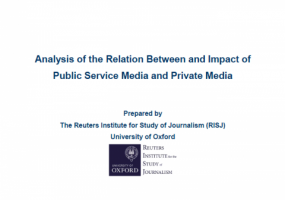News Embargoes - Under threat, but not extinct

Reuters Institute Fellow's Paper
Sonja Gruber, an editor at the business department of the Austrian Press Agency in Vienna, has written a comprehensive overview of the present state and future prospects of the news embargo.
Her key finding in her paper ‘News Embargoes - Under threat, but not extinct: How an ancient press tool survives in the modern media world’ is that the news embargo has not yet outlived its purpose. But in the current speeded-up, digital and fragmented media world, the acceleration and the economic challenges journalism faces is putting it under enormous pressure. In the past the news embargo has not been examined in academic writings. It was invented a century ago, primarily for practical reasons. Sources provide journalists with news which should not to be published until a certain date. In theory, both sides benefit from such an agreement. The ever-pressurised journalist has time to prepare the story properly and thus the source is more likely to get accurate coverage of the given topic. In the ‘old world’, embargoes used to be timed particularly to print deadlines of newspapers. Those days are long gone, but even in the 24/7 news environment, both sources and journalists interviewed in her paper defend the use of the embargo, basically with the same arguments as decades ago.
Sonja shows how the use of the embargo varies from field to field. Based on interviews with PR professionals, journalists and academics, she has identified different types of embargoes: the embargo in science journalism, the political embargo, the embargo used by institutions that release market-sensitive data, the embargo imposed by private corporations and the news agencies’ embargo. In science journalism, the embargo has been a core part of the media policy of major science journals since the 1920s and remains so. In contrast, in business journalism, the possibility of putting news out right away on the internet, notably via Twitter, and also the computerisation of trading have put tremendous pressure on financial embargoes. Nonetheless these embargoes will not become extinct in the near future, Sonja concludes.
Instead, it may go in very different directions: government agencies tend to tighten their security measures to prevent early leakage of data rather than abolish their embargo systems; whereas listed companies no longer withhold market-sensitive information, but still deploy the embargo when it comes to ‘softer topics’. In general, selling stories in advance has become difficult for PR companies because journalists are increasingly urged to put out news right away. However, time pressure is still the main reason why journalists still adhere to the embargo, but only on ‘hard news’. Moreover, they don’t see the point in breaking embargoes, even though the sanctions sources threaten them with are rarely implemented.
Sonja concludes that the fragmentation of news consumption habits boosted by the rise of mobile devices is going to disrupt the embargo. Sources are going to have think more about the issue of timing, as they will still want to maximize the impact of their message. The media context behind the embargo is only going to become more complicated.
As with all Fellows’ research papers, any opinions expressed are those of the author and not of the Institute.
Image: http://www.buynothingnew.org/2017/06/sole-treadmill-reviews.html






